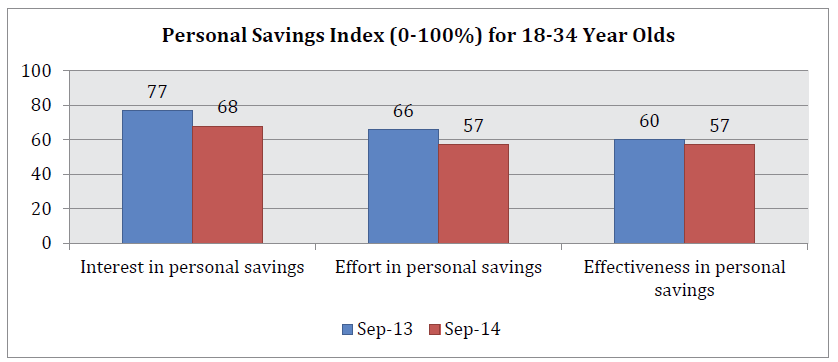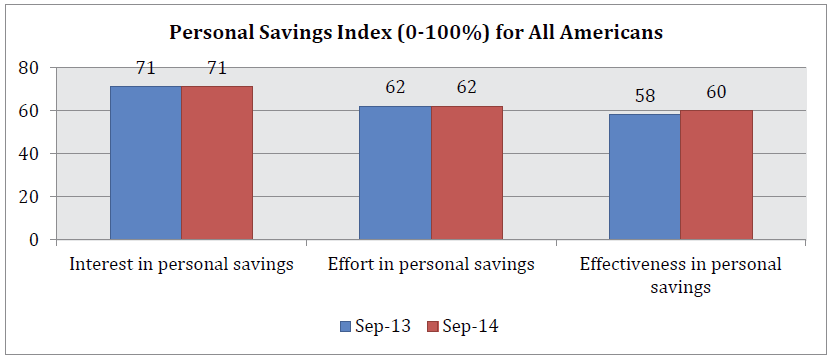Washington, D.C. – Between September 2013 and September 2014, the personal savings interest and effort of young adults declined considerably, according to data collected by America Saves for its triannual Personal Savings Index (PSI). During this period, interest in personal savings for those 18-34 years old fell from 77 percent to 68 percent, while the reported savings effort of these young adults declined from 66 percent to 57 percent. Reported savings effectiveness for this group was also lower – 60 percent a year ago but only 57 percent last month.
“A combination of low incomes and high debts may help explain the decline in personal savings interest and effort by young adults,” noted Stephen Brobeck, Consumer Federation of America (CFA) Executive Director and a founder of America Saves. “All the data we’ve collected over the past year in our national surveys suggest that those who are struggling financially have lower levels of personal savings interest and effort,” he added.
In September 2013, January 2014, May 2014, and September 2014, America Saves commissioned national surveys undertaken by ORC International of 1000 representative adult Americans. Respondents were asked, after learning that the survey dealt with “personal saving for goals ranging from a rainy day fund to retirement,” to rate their personal savings interest, effort, and effectiveness on a ten-point scale. ORC International reported averages and distributions of responses. The company conducted the surveys by landline and cell phone. The surveys had a margin of error of plus or
minus three percentage points.
The four surveys revealed other important findings about savings interest, effort, and effectiveness. With one major exception, for the whole population during the past year, there was little change in the three PSI values. In September 2013, savings interest was 71 percent, savings effort was 62 percent, and savings effectiveness was 58 percent. In September 2014, interest was 71 percent, effort was 62 percent, and effectiveness was 60 percent. The slight rise in effectiveness was not statistically significant but may hint at an improvement in general economic conditions.
The one major exception to this consistency was lower interest (65%), effort (58%), and effectiveness (56%) found in the January 2014 survey. These lower numbers probably reflect the fact that, after the holiday season, Americans are less focused on saving and more focused on paying bills and debts accumulated in November and December.
Among the four major regions of the country – Northeast, Midwest, South, and West – savings interest (77%), effort (67%), and effectiveness (63%) were highest in the West. That was also the case in the three earlier surveys. The higher one’s income, the greater one’s savings interest, effort, and
effectiveness. In September 2014, those with household incomes below $25,000 had interest of 61 percent, effort of 53 percent, and effectiveness of 52 percent, while those with incomes above $100,000 had interest of 80 percent, effort of 73 percent, and effectiveness of 68 percent. “Clearly one’s financial resources have a great impact on savings interest and reported effort and effectiveness,” said CFA’s Brobeck. “The lower one’s income, the more likely one is preoccupied with paying bills and convinced one cannot afford to save,” he added.
America Saves Expands Efforts to Encourage and Facilitate Saving by Young Employees
America Saves is promoting saving at work for young adults as one effort to increase overall workplace saving. Over the past three summers, America Saves has begun its work in this area with a large and vulnerable population, young first-time summer workers from low-income households. “These young people are inexperienced about personal finance and are less likely to save any of their earnings,” said George Barany, America Saves Director of Financial Education. “We’re setting them up with the same system millions of adults use to save. Why not give them the same opportunities to save money that we have?”
Through this program, young employees are encouraged to save a portion of their paycheck through direct deposit by identifying a savings goal, committing to save a portion of their paycheck towards that goal, and setting up direct deposit into an existing or new account. This past summer, America Saves expanded from three cities to 13 cities across nine states where 3,962 youth pledged to save $2,772,707.46.
Contacts: Katie Bryan, 202-939-1018; Jack Gillis, 202-737-0766
America Saves, a campaign managed by the nonprofit Consumer Federation of America, seeks to motivate, encourage, and support low- to moderate-income households to save money, reduce debt, and build wealth. The research-based campaign uses the principles of behavioral economics and social marketing to change behavior. Non‐profit, government, and corporate groups participate in America Saves nationally and through local, regional, and statewide campaigns around the country. America Saves encourages individuals and families to take the America Saves pledge and organizations to promote savings year-round and during America Saves Week. Learn more at americasaves.org and americasavesweek.org.


